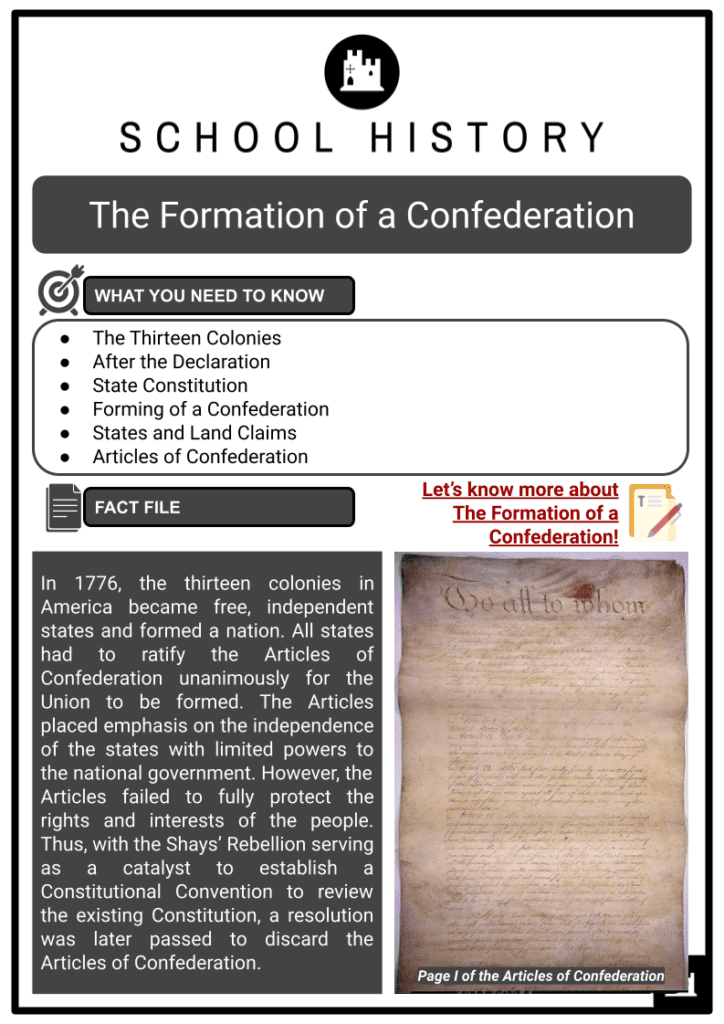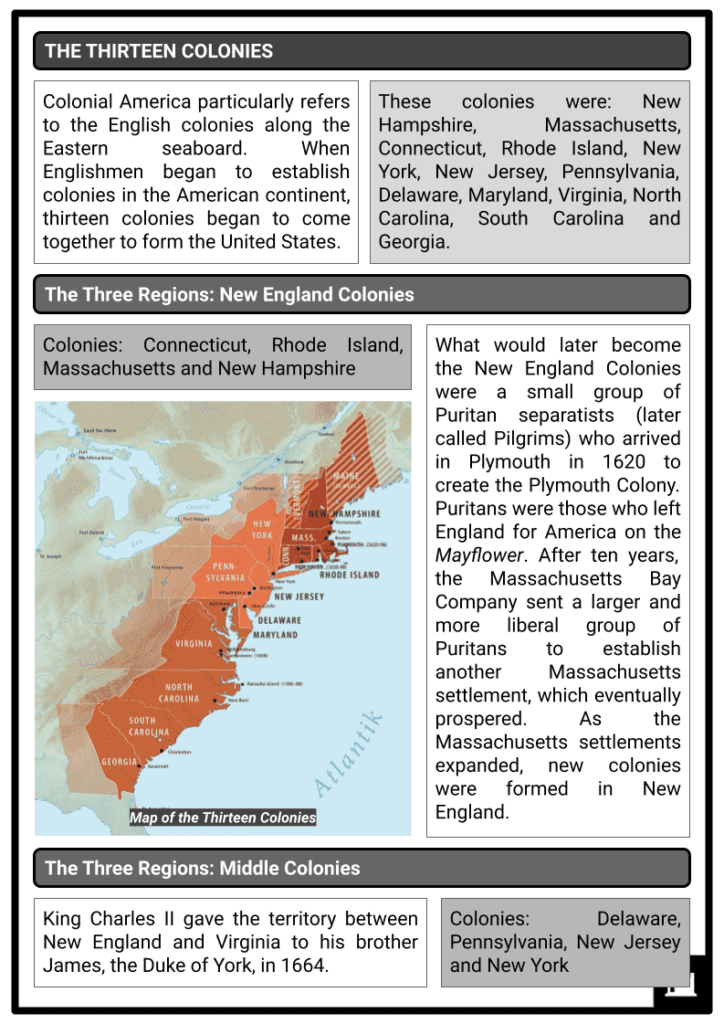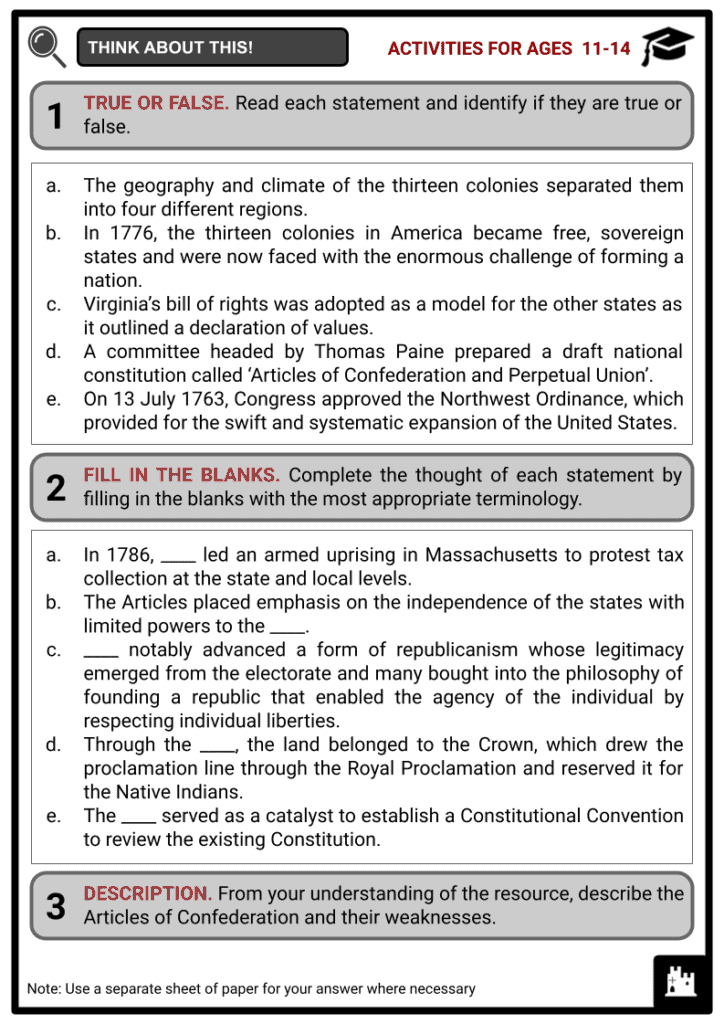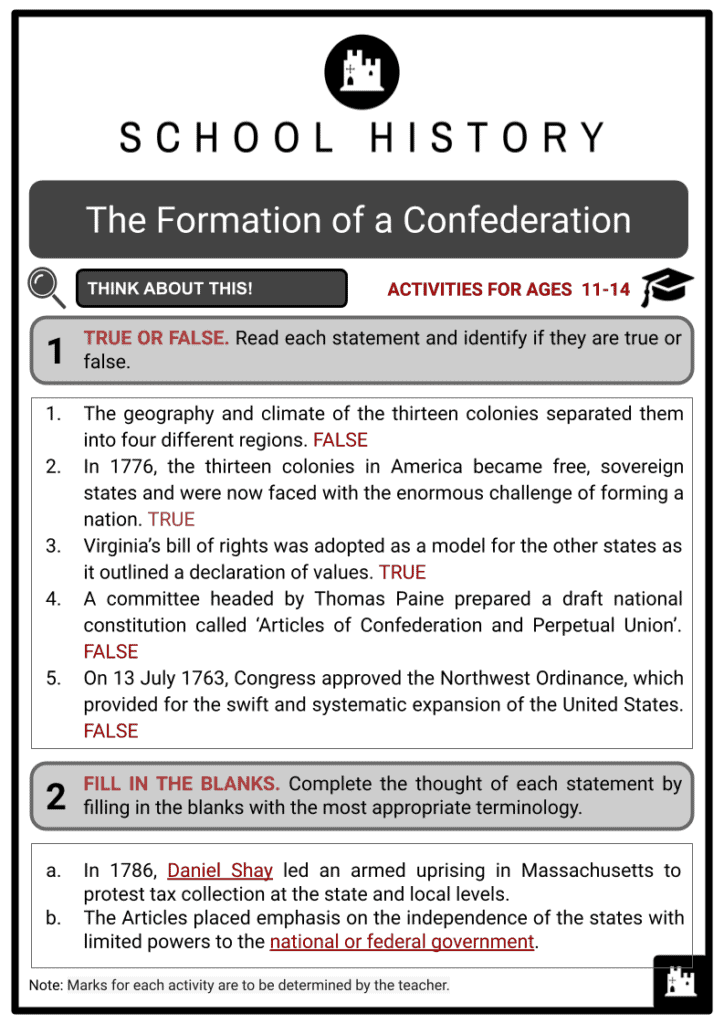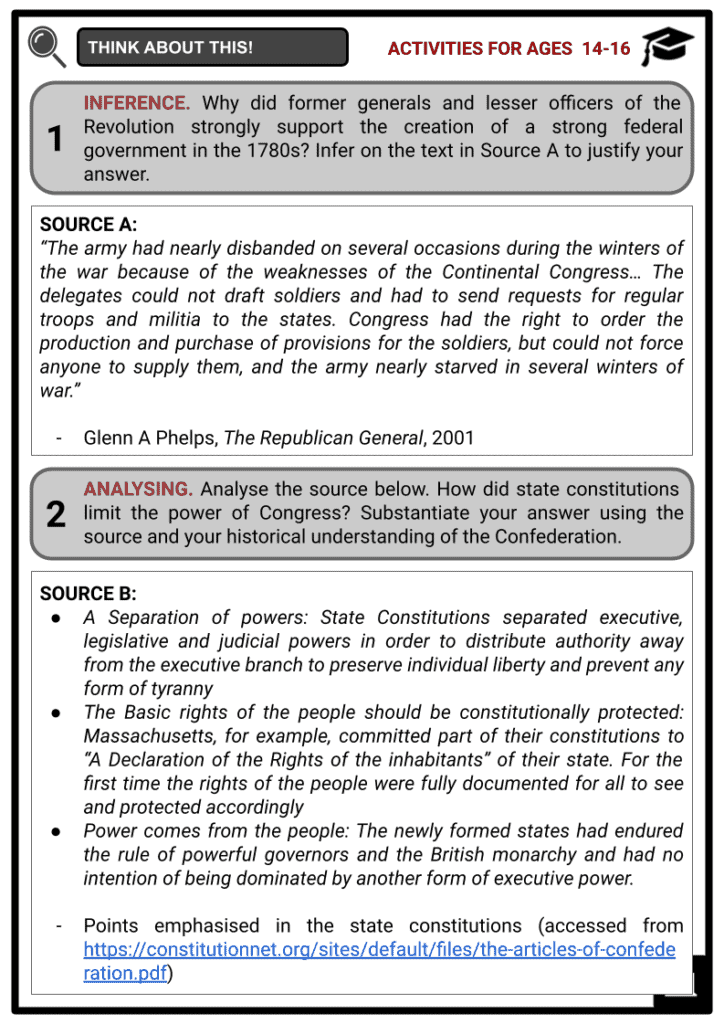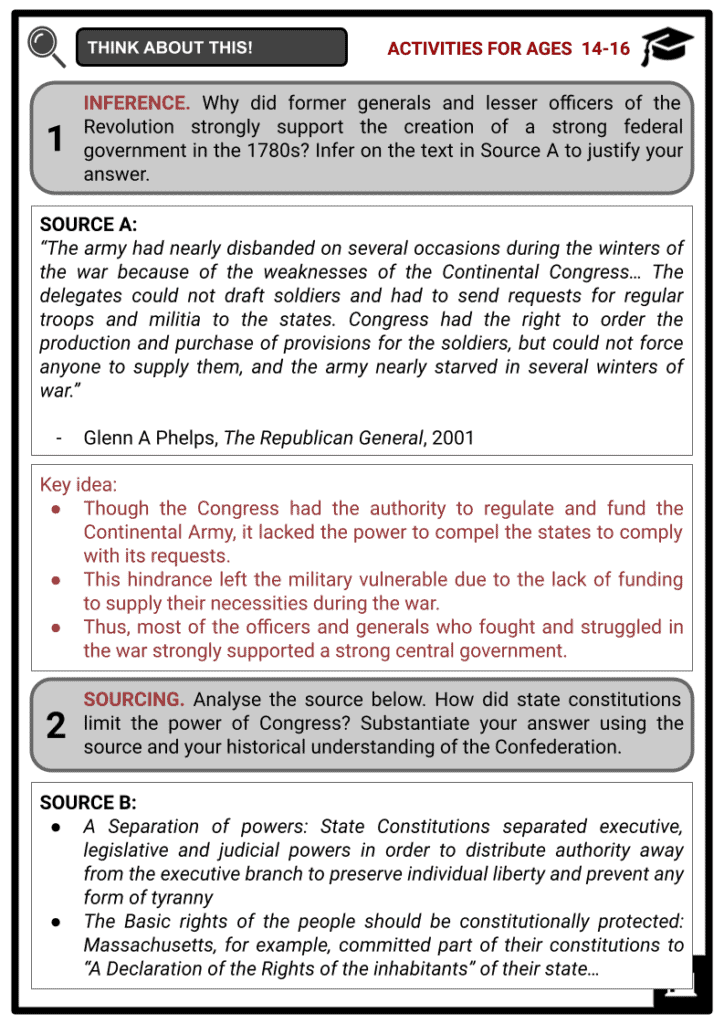The Formation of a Confederation Worksheets
Do you want to save dozens of hours in time? Get your evenings and weekends back? Be able to teach about the Formation of a Confederation to your students?
Our worksheet bundle includes a fact file and printable worksheets and student activities. Perfect for both the classroom and homeschooling!
Summary
- The Thirteen Colonies
- After the Declaration
- State Constitution
- Forming of a Confederation
- States and Land Claims
- Articles of Confederation
Key Facts And Information
Let’s find out more about the Formation of a Confederation!
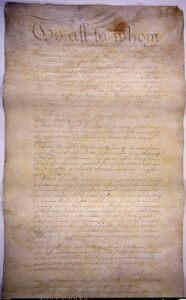
In 1776, the thirteen colonies in America became free, independent states and formed a nation. All states had to ratify the Articles of Confederation unanimously for the Union to be formed. The Articles placed emphasis on the independence of the states with limited powers to the national government. However, the Articles failed to fully protect the rights and interests of the people. Thus, with the Shays’ Rebellion serving as a catalyst to establish a Constitutional Convention to review the existing Constitution, a resolution was later passed to discard the Articles of Confederation.
THE THIRTEEN COLONIES
- Colonial America particularly refers to the English colonies along the Eastern seaboard. When Englishmen began to establish colonies in the American continent, thirteen colonies began to come together to form the United States.
- These colonies were: New Hampshire, Massachusetts, Connecticut, Rhode Island, New York, New Jersey, Pennsylvania, Delaware, Maryland, Virginia, North Carolina, South Carolina and Georgia.
The Three Regions: New England Colonies
- Colonies: Connecticut, Rhode Island, Massachusetts and New Hampshire.
- What would later become the New England Colonies were a small group of Puritan separatists (later called Pilgrims) who arrived in Plymouth in 1620 to create the Plymouth Colony. Puritans were those who left England for America on the Mayflower. After ten years, the Massachusetts Bay Company sent a larger and more liberal group of Puritans to establish another Massachusetts settlement, which eventually prospered. As the Massachusetts settlements expanded, new colonies were formed in New England.
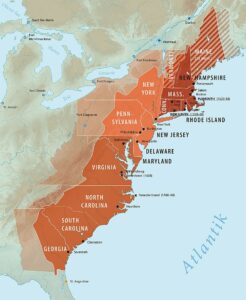
Map of the Thirteen Colonies
The Three Regions: Middle Colonies
- Colonies: Delaware, Pennsylvania, New Jersey and New York.
- King Charles II gave the territory between New England and Virginia to his brother James, the Duke of York, in 1664.
- Since the territory was already occupied by Dutch traders and landowners, as well as Belgian Flemings and Walloons, French Huguenots, Scandinavians and Germans, New York became one of the most diverse of the colonies.
- Moreover, in 1681 William Penn, out of royal debt, founded the new colony of Pennsylvania. This colony soon became a prosperous and relatively egalitarian place.
The Three Regions: Southern Colonies
- Colonies: Maryland, Virginia, North Carolina, South Carolina and Georgia.
- The Carolina colony was much less a cosmopolitan area with agriculture being a main source of income. These Carolinians developed close ties with the English planter colony on the Caribbean island of Barbados, which relied heavily on African slave labour. As a result, slavery played an important role in the development of the Carolina colony.
- In addition to the southern colonies, Englishman James Oglethorpe established the Georgia colony in 1732 to build a buffer between South Carolina and the Spanish settlements in Florida. Georgia, like Carolina, was also mainly agricultural.
AFTER THE DECLARATION
- In 1776, the thirteen colonies in America became free, sovereign states and were now faced with the enormous challenge of forming a nation.
- Before and during the revolution, with the help of public political commentators such as Thomas Paine, the colonies took time to reflect on the form of government that would be suitable for the colonies.
- The values of the nation at the time were reflected in the Declaration of Independence.
- Thomas Paine notably advanced a form of republicanism whose legitimacy emerged from the electorate and many bought into the philosophy of founding a republic that enabled the agency of the individual by respecting individual liberties. In 1776, the Continental Congress mandated the colonies to draft new state constitutions and the colonies used the colonial charters as the basis for developing the constitutions.
STATE CONSTITUTION
- Connecticut and Rhode Island, for instance, amended their colonial charters to remove references to the Crown and adopted the sections that remained as their constitution.
- Other states were careful to make adequate provisions for the separation of power between the state governments and legislatures and a balance of power between the states and the national government. Because of their relationship with the Crown, the states were averse to creating a national government with too much power.
- The assembly of Massachusetts Bay held a special convention to develop their constitution. The document was then submitted to the people during town meetings, provided that two-thirds of the people required to ratify the document attended. The process was adopted in the ratification of the federal constitution.
- The constitutions of the new states were borrowed from the British respect for status, fairness and due process, along with the American philosophy for the esteem of the individual, and checks were in place to curtail excess executive branch.
- Individual rights were spelt out in the Bill of Rights, which protected the people from the three branches of governments.
- Virginia’s bill of rights was adopted as a model for the other states as it outlined a declaration of values such as popular sovereignty, rotation in office, freedom of election, and fundamental rights such as humane punishment, rapid trial by jury, freedom of press and conscience, and the right of the majority to alter the form of government.
- Other states also included the freedom of speech, assembly, and the right to petition the government. Right to bear arms, writ of habeas corpus, and the right of equal protection by the law were added to different states with time.
FORMING A CONFEDERATION
- However, the constitutions failed to secure equality for women in politics, and the rights of slaves in the southern colonies were not considered inalienable. No state permitted universal male suffrage. At this point, there was also no government, and the Continental Congress, a convention of delegates from the colonies, recognised they were a legislative organ functioning as an executive without a constitutional mandate.
- A committee headed by John Dickinson prepared a draft national constitution called ‘Articles of Confederation and Perpetual Union’ that was debated by the Continental Congress for one year before being submitted to the thirteen states for ratification. It would come into effect only upon the consensus of all the states.
STATES AND LAND CLAIMS
- Some states had land issues that they wanted settled before the ratification of the Constitution. Massachusetts, Virginia, North Carolina, South Carolina and Georgia claimed that their charter provided for land ‘from sea to sea’ between the mountains and the Mississippi River. New York claimed that they had obtained the land title of the Ohio Valley from the Native Indians.
- Rhode Island, New Hampshire, Delaware, New Jersey, Pennsylvania and Maryland had no claims to western lands as their charters were not ‘from sea to sea’.
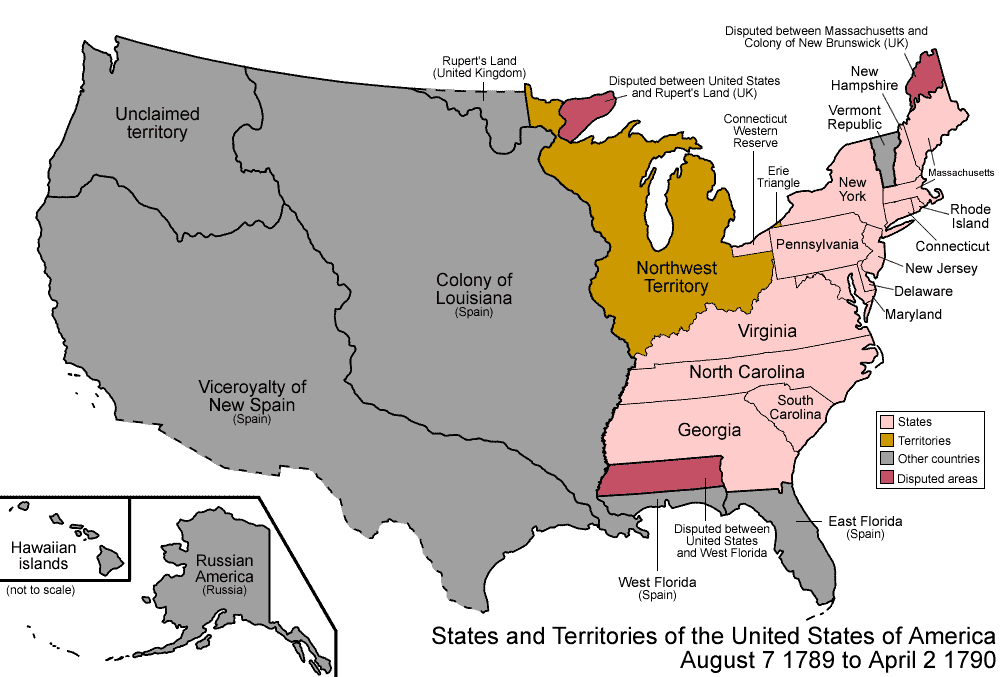
Map of the states and territories of the US after the Northwest Ordinance - New Jersey, Delaware and Maryland objected to the state land claims stating that the claims were invalid, and they would not ratify the Articles until the states abandoned their land claims. The objections raised were rooted in the history of the western hemisphere, which was discovered, explored and owned by the French until 1763 when France ceded the territory to the Crown after the French Indian Wars.
- Through the Peace Treaty of 1763, the land belonged to the Crown, which drew the proclamation line through the Royal Proclamation and reserved it for the Native Indians. In the following three years, the states with claims refused to concede to the objections raised. New Jersey and Delaware ratified the constitution, but Maryland did not ratify until 1 March 1781 when the other states vacated their claims.
- The ratification process transformed America into the United States and on 13 July 1787 Congress approved the Northwest Ordinance, which allowed for the swift and systematic expansion of the United States.
- However, the Continental Congress lacked the mandate to levy taxes, had no courts, nor the ability to regulate trade, and its resolutions were not binding to the states individually or collectively.
- The states were also fairly independent: a set of laws in one state did not necessarily apply in another. Each state, having only one vote regardless of size, was to vote on issues concerning wars, treaties, currency, finances and military, and a minimum of nine states were required to give their approval for matters to pass in the Continental Congress. Constitutional amendments were subject to the unanimous support of all the states.
ARTICLES OF CONFEDERATION
- The Articles of Confederation were ratified in 1781, outlining the laws of the country. State governments possessed more power compared to the federal government. Since its formal adoption, the American flag has been officially modified 26 times. The original thirteen stars and stripes in the flag represented the original thirteen colonies.
- In 1786, Daniel Shay led an armed uprising (known as the Shays’ Rebellion) in Massachusetts to protest tax collection at the state and local levels. The national government failed to handle the situation in the area. The rebellion served as a catalyst to establish a Constitutional Convention to review the existing Constitution. Later on, a resolution was passed to discard the Articles of Confederation.
Weaknesses of the Articles of Confederation
- Regardless of the size of the state’s territory, they only had one vote in the United States Congress.
- The US Congress had no taxation powers or regulatory powers on foreign and interstate commerce.
- Under the Articles of Confederation, there was no executive branch to implement acts of Congress.
- There was no national court system. In addition, amendments to the Articles of Confederation needed a unanimous vote, while laws needed a majority vote (9 out of 13 states) to be passed in Congress.
Image Sources
- https://upload.wikimedia.org/wikipedia/commons/thumb/b/b4/Articles_page1.jpg/800px-Articles_page1.jpg
- https://upload.wikimedia.org/wikipedia/commons/thumb/d/d3/Thirteencolonies_politics_cropped.jpg/800px-Thirteencolonies_politics_cropped.jpg
- https://upload.wikimedia.org/wikipedia/commons/e/eb/United_States_1789-08-1790-04.png

